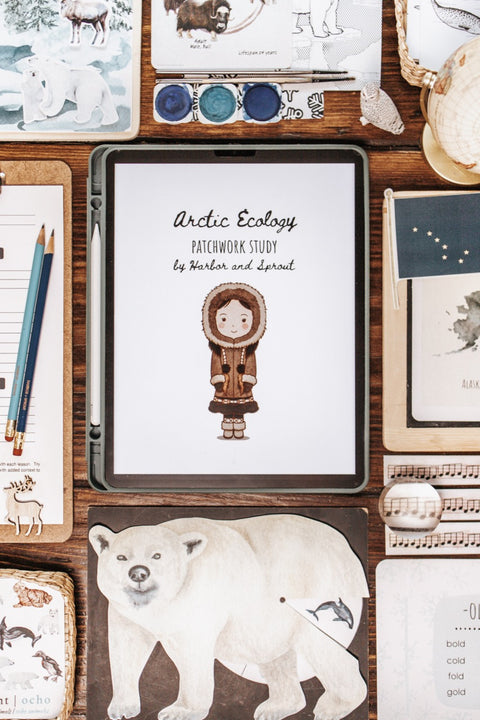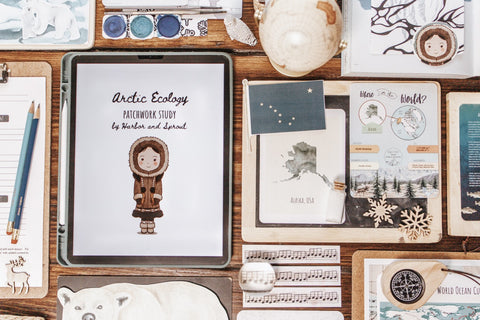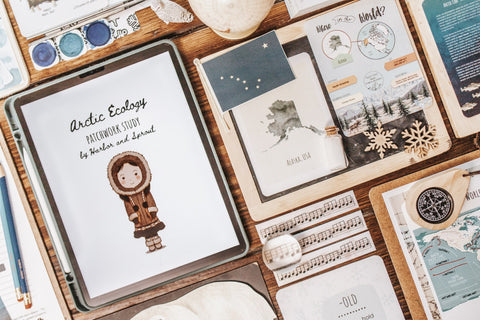


























Harbor and Sprout
Arctic Ecology Patchwork Study
Welcome to the Harbor + Sprout Arctic Ecology Patchwork Study, the November 2024 release of our original elementary-level homeschool unit study curriculum. This unit study features 4 weeks of lesson plans and materials covering all 9 of our core subjects and a playful supplemental section of thematic activities. This unit study is meant for use by children ages 3-12.
Click here to download a free sample of a Patchwork Study.
This unit is delivered via a secure link as a digital download.
CONTENT:
Handbook
Daily, weekly, and monthly planning pages
Book list including stories, poems, and field guides with recommended ages, subject correspondence, and brief summaries for each title
Scope and Sequence
Family read aloud with discussion guide and recipe
Character kit- new monthly character illustrated by Stephanie Groves to act as your guide through the unit
Science
Lesson 1: What is Arctic Ecology? In this lesson, you will learn all about the attributes of an arctic environment and how living things interact with that environment. You will discover the Taiga habitat, simulate an ice core sample, and conduct a greenhouse gas lab.
Lesson 2: What Animals Live in the Arctic? In this lesson, you will discover the different types of animals that live in the Arctic and why they are able to survive in such extreme conditions. You will study the muskox anatomy and life cycle and solve food webs.
Lesson 3: What is it Like in the Arctic? In this lesson, you will discover what it would be like to live in the Arctic. You will explore Earth’s magnetic field and how that creates an all natural light show and how the seasons look a little different in the arctic regions.
Lesson 4: How Can You Survive in the Arctic? In this lesson, you will explore adaptations and skills that many animals have mastered in order to cope with their environment. You will learn all about survival skills, like, camouflage, insulation, and blubber.
Nature Study
Lesson 1: The Arctic Ocean- In this lesson, you will explore the major currents in the Arctic Ocean, see what happens when warm and cold currents collide in our simulation, and discover the different types of sea ice in the Arctic Ocean and how they form.
Lesson 2: Marine Life- In this lesson, you will explore the role of marine creatures within the Arctic Ocean ecosystem, collect local water sources to observe plankton under a microscope, celebrate the life cycle of Beluga Whales, and mimic whale calls.
Lesson 3: Life on the Ice- In this lesson, you will explore the role of land and air creatures within the Arctic Ocean ecosystem, discover how blubber keeps some animals warm while they live their life on ice, and track polar bears to understand their habitat.
Lesson 4: Climate Change- In this lesson, you will explore how the Arctic keeps our planet “cool”, learn how climate change and greenhouse gases are leading to melting ice and rising sea levels, and discover what you can do to help.
Language Arts
Lesson 1: Arctic Words- In this lesson, you will explore Arctic-themed words with fun activities. You will practice your spelling skills, dive deeper into the meaning and origin of these words, unscramble them, and write a story with your new vocabulary.
Lesson 2: Aurora Borealis- In this lesson, you will read and explore the lovely poem, “Aurora Borealis,” by Candadian born poet, Nellie Seelye Evans. You will summarize the poem, answer study questions, and recreate the incredible Northern Lights.
Lesson 3: Plural Nouns- In this lesson, you will study the rules that take nouns from singular to plural (and some of the rule breakers). You will practice using and writing plural nouns by reviewing many types of Arctic animals and play Arctic Bingo!
Lesson 4: Active and Passive Voice- In this lesson, you will learn what a voice is in grammar and that English has two grammatical voices: active voice and passive voice. You practice identifying the subject and verb in a sentence and whether it is active or passive.
Writing
Lesson 1: Summarizing- Over the next four lessons, you will learn how to write a book report about a famous person. In this lesson, you will find your book, read the book, and then write down what you learned about that person from the book to form your summary.
Lesson 2: Creating a Timeline- In this lesson, you will create a timeline about your famous person. You will explore the important events of their life, decide what to report on, write and sentence or two about each event, and place them in chronological order.
Lesson 3: Personal Connections- In this lesson, you will explore any personal connections you’ve made while reading your book. You will consider what you’ve learned, how you relate to their experience, how they have influenced your life, and so on.
Lesson 4: Famous Person Project- In this lesson, you will finalize your project with all the information you’ve collected and recorded thus far: important facts, a timeline, and personal connections. You will explore presentation ideas and create!
History
Lesson 1: Historic Peoples of the Arctic: Sami- In this lesson, you will discover what and how an ecologist studies in the arctic, a brief history of arctic ecology, and a group of indigenous people called the Sami. You will also expand your knowledge of the Northern Lights.
Lesson 2: Historic Peoples of the Arctic: Inuit- In this lesson, you will explore another group of indigenous people of arctic regions called Inuit, the places where they take residence, their traditions and beliefs, and the animals that a play a role in their culture.
Lesson 3: Historic Peoples of the Arctic: Chukchi- In this lesson, ou will learn about two groups of Arctic people, the Reindeer Chukchi and the Maritime Chukchi. You will discover a brief history of their origins, and then explore their similarities and differences in culture.
Lesson 4: Finding the North Pole- In this lesson, you will learn about explorers who traveled in, around, and through the Arctic Circle. You will discover what the North Pole really looks like, conditions that surround it, and why it was incredibly difficult to reach it.
Geography
Lesson 1: Alaska, USA- In this lesson, you will explore the facts, statistics, and characteristics of Alaska. You will learn about its great history, state song, symbolism of the flag, location on a map, and fun trivia to impress the geography buff in your life.
Lesson 2: Maps- In this lesson, you will familiarize yourself with the continent of North America and the state of Alaska within the USA. You will practice locating various bodies of water and land masses on the world map and map of Alaska.
Lesson 3: Alaskan Culture and History- In this lesson, you will learn about the culture, music, cuisine, and sports important to the people of Alaska. You will discover the different groups of indigenous people that call Alaska home and their distinct cultures.
Lesson 4: The Arctic Circle- In this lesson, you will learn to identify the lines of latitude and longitude on a map and the names of some significant lines. You will a little deeper into the Arctic Circle and how its location effects much of its animal life and weather.
Music
Lesson 1: Exploring Musical Form- In this lesson, you will explore patterns that occur in nature and music. You will dive deep into some common examples of musical form (binary form, ternary form, rando form, and verse-chorus form) and learn how to identify them.
Lesson 2: Free-flowing Musical Forms- In this lesson, you will discover that although musical forms give nice structure, there are also unpredictable types of music that give an even more unique sound and catches the listeners attention.
Lesson 3: Chilly Compositions: Classical Songs Inspired by the Arctic: In this lesson, you will learn about two composters who allowed the natural sounds of the Arctic inspire their music. You will listen to the music of Einojuhani Rautavaara and Vincent Ho and then read a brief history of their lives.
Lesson 4: Instruments of the Arctic- In this lesson, you will explore the drum of the Arctic called Qilaut through how its made, how its played, and how its rich culture and spiritual history has shaped its importance. You will learn the different parts of the instrument.
Art
Lesson 1: Wildlife Portraits- In this lesson, you will portray the beautiful Arctic landscape and wildlife through pop art, sculpture, paint scraping, and free form coloring pages. You will learn about the talented Norwegian painter, Harald Sohlberg.
Lesson 2: Landscapes & Light- In this lesson, you will capture the beauty of nature by painting, coloring, and constructing the Arctic landscape with a special focus on the stunning Aurora Borealis. You will learn about the American artist, Rockwell Kent.
Lesson 3: Arctic Flora- In this lesson, you will explore flowers, leaves, and trees that thrive in the Arctic (and you might be surprised that everything is not covered in snow). You will learn about a Finnish artist (Akseli Gallen-Kallela) who celebrated nature.
Lesson 4: Shapes and Patterns- In this lesson, you will discover the naturally occurring shapes and patterns made by snow and ice and capture them in art. You will learn about remarkable English explorer and artist, Edward Wilson.
Math
Lesson 1: Polar Bear, Polar Bear, What’s the Number?: In this activity, you will practice counting and basic math with Arctic animals. You will randomly assign numbers to animals and cut out a spinning wheel to create a fun math game that can be played again and again.
Lesson 2: Arctic Animals Map Skills- In this activity, you will learn to use coordinates on a grid while studying Arctic animals. You will familiarize yourself with the grid, find the animals, record the coordinates, and, as an added challenge, create your own path.
Lesson 3: Ice Floe Number Sequence- In this activity, you will learn and practice number sequencing by filling in the missing numbers. Sequences may be in order from smallest to largest or largest to smallest and will cover number from singles digits to three digits.
Lesson 4: Arctic Ecology Math Bingo- In this activity, you will play Arctic Ecology Math Bingo. You will use your simple addition skills to solve math problems, match the answers to the numbers on your card, and shout BINGO when you get a full line.
Supplement
- Arctic coloring pages
- Crossword
- Word and picture cards
- I Spy and /Count
- Bird Drawing
- Memory Match
- Cut and Count activity
- Tic Tac Toe
- Arctic animal counting puzzles
- Arctic animal counting
- Coloring pages
This unit is delivered as a downloadable zip file. H+S Patchwork Studies average approximately 550-650 pages of content. While the download does include the option to print the full unit straight through front and back, we recommend printing on an as-needed, as-you-go basis. Enjoy your Arctic Ecology adventures!
